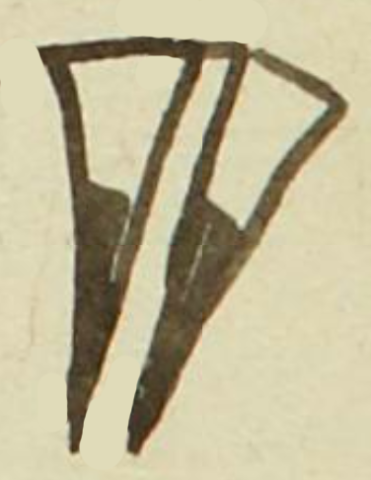Huitznahuacatl (MH755v)
This black-and-white painting of the simplex glyph for the name or ethnicity, Huitznahuacatl (“Person from Huitznahuac”), is attested here as pertaining to a man. The glyph here would double for the glyph of the place name, Huitznahuac (“Near the Thorns”). It consists of a frontal view of two triangular thorns (huitztli), point side down, black on the lower half (the points) and white on the upper ends. More commonly, tlacuilos painted such thorns with the points upward, as shown below. The dark tips may intend to suggest that they are bloody because of their use in bloodletting. The two thorns are near (-nahuac) each other.
Stephanie Wood
There is a “Huisnahuac” near Tetzcoco (Texcoco, today). Huitznahuac is the name of one of the seven groups (calpulli) that emerged from Chicomoztoc (the “Seven Caves”) in the legendary migration that would lead to the founding of Mexico-Tenochtitlan.
Stephanie Wood
1560
Jeff Haskett-Wood
espinas, sangre, flebotomía, ofrendas, autosacrificio, pueblos, etnicidades, nombres de hombres, nombres de lugares

Huitznahuac, a place, a calpolli from Chicomoztoc, an ethnicity, warrior-dancers, https://nahuatl.wired-humanities.org/content/huitznahuac
-catl, affiliation suffix, https://nahuatl.wired-humanities.org/content/catl
huitz(tli), a thorn or spine, https://nahuatl.wired-humanities.org/content/huitztli
-nahuac, next to, https://nahuatl.wired-humanities.org/content/nahuac
(una persona de Huitznahuac)
Stephanie Wood
Matrícula de Huexotzinco, folio 755v, World Digital Library, https://www.loc.gov/resource/gdcwdl.wdl_15282/?sp=589&st=image
This manuscript is hosted by the Library of Congress and the World Digital Library; used here with the Creative Commons, “Attribution-NonCommercial-ShareAlike 3.0 License” (CC-BY-NC-SAq 3.0).







